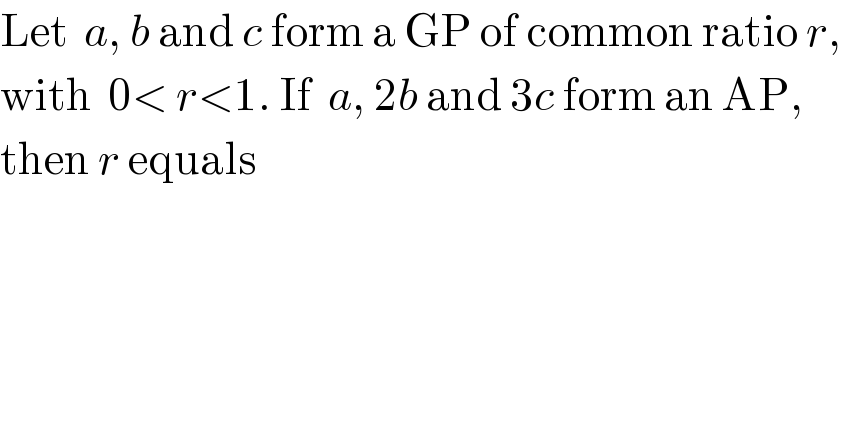
Question Number 56420 by gunawan last updated on 16/Mar/19

$$\mathrm{Let}\:\:{a},\:{b}\:\mathrm{and}\:{c}\:\mathrm{form}\:\mathrm{a}\:\mathrm{GP}\:\mathrm{of}\:\mathrm{common}\:\mathrm{ratio}\:{r}, \\ $$ $$\mathrm{with}\:\:\mathrm{0}<\:{r}<\mathrm{1}.\:\mathrm{If}\:\:{a},\:\mathrm{2}{b}\:\mathrm{and}\:\mathrm{3}{c}\:\mathrm{form}\:\mathrm{an}\:\mathrm{AP}, \\ $$ $$\mathrm{then}\:{r}\:\mathrm{equals} \\ $$
Answered by tanmay.chaudhury50@gmail.com last updated on 16/Mar/19
![a=a b=ar c=ar^2 2(2b)=a+3c 2(2ar)=a+3(ar^2 ) 4r=1+3r^2 3r^2 −3r−r+1=0 3r(r−1)−1(r−1)=0 (r−1)(3r−1)=0 r≠1 [given in question] r=(1/3)](Q56442.png)
$${a}={a} \\ $$ $${b}={ar} \\ $$ $${c}={ar}^{\mathrm{2}} \\ $$ $$\mathrm{2}\left(\mathrm{2}{b}\right)={a}+\mathrm{3}{c} \\ $$ $$\mathrm{2}\left(\mathrm{2}{ar}\right)={a}+\mathrm{3}\left({ar}^{\mathrm{2}} \right) \\ $$ $$\mathrm{4}{r}=\mathrm{1}+\mathrm{3}{r}^{\mathrm{2}} \\ $$ $$\mathrm{3}{r}^{\mathrm{2}} −\mathrm{3}{r}−{r}+\mathrm{1}=\mathrm{0} \\ $$ $$\mathrm{3}{r}\left({r}−\mathrm{1}\right)−\mathrm{1}\left({r}−\mathrm{1}\right)=\mathrm{0} \\ $$ $$\left({r}−\mathrm{1}\right)\left(\mathrm{3}{r}−\mathrm{1}\right)=\mathrm{0} \\ $$ $${r}\neq\mathrm{1}\:\left[{given}\:{in}\:{question}\right] \\ $$ $${r}=\frac{\mathrm{1}}{\mathrm{3}} \\ $$
